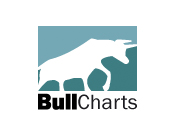
 |
Trailing Stops in TradeSim scans |
Post Reply 
|
| Author | |
Peter 
BullCharts Staff 
Joined: 09 Sep 2004 Location: Australia Posts: 241 |
 Post Options Post Options
 Quote Quote  Reply Reply
 Topic: Trailing Stops in TradeSim scans Topic: Trailing Stops in TradeSim scansPosted: 23 Jun 2005 at 9:28am |
|
For those who have started investigating the new TradeSim scans, one of the big questions has been "What about Trailing Stops".
The TradeSim application note AN2 by Compuvision describes how TradeSim customers can add a volatility trailing stops based on the ATR when using Metastock. This method can also be applied to BullCharts with some small modifications. As an aside, you can use the BullScript scans in BullCharts to create TradeSim scans, in the same way that you can in Metastock. All of the TradeSim external functions, including ExtFml("TradeSim.TrailingStop") can be used in the same way in this context. The rest of this discussion relates to using the nicer user-interface based TradeSim BullScan. As the AN2 notes describe, any trailing stop needs to be included as part of the Exit Trigger. Therefore, in BullScan, you need to include any Trailing Stops on the Exit Tab of the editor (not the stops tab). The reason for this is that TradeSim only calculates any Initial Stop script once on the day of entry, which is unsuitable for trailing stops as their value changes over time. Adding an ATR trailing stop to a system:
Period:=10;
If you had any other exit conditions, you can add them to the script now. For example: ... ExtFml( "TradeSim.TrailingStop", TRIGGER, LONG, Volatility, CLOSE, LOW) OR CROSS(MA(C,20,S),MA(C,10,S));ARC:=3; Volatility:=ARC*ATR(Period); { Trailing Stop Exit on the Long side } ExtFml( "TradeSim.TrailingStop", TRIGGER, LONG, Volatility, CLOSE, LOW) See the AN2 document for a more detailed discussion of how this stop works. In general, an Exit Trigger described in any of the TradeSim manual notes can be pasted into the BullCharts Exit tab in this way - by removing the final ExitTrigger:= and any inputs. |
|
 |
|
theedge 
Newbie 
Joined: 11 Feb 2007 Location: Australia Posts: 1 |
 Post Options Post Options
 Quote Quote  Reply Reply
 Posted: 11 Feb 2007 at 11:30pm Posted: 11 Feb 2007 at 11:30pm |
|
Hi Peter: Thanks for the pointer about trailing stops. However, I am having real difficulty with non-returning stops, such as the non-returning mean close trailing stop. A formula is provided in 'Breakthrough Trading', and is included in the version of BullCharts I have purchased recently, however, this is for visual scanning purposes. When I try to convert the code for use on the Exit tab of a TradeSim trading system, I can't seem to make the non-returning part of it work. Any pointers to where I might find working code I can adapt? |
|
 |
|
chart rider 
Regular 
Joined: 25 Sep 2004 Location: Australia Posts: 96 |
 Post Options Post Options
 Quote Quote  Reply Reply
 Posted: 12 Feb 2007 at 6:31pm Posted: 12 Feb 2007 at 6:31pm |
|
edge Peter left Bullcharts some time ago and you wont get a reply from anybody else in the company. If you can provide further explanation about the particular stop you are trying to code, perhaps I or another reader can help out. CR |
|
 |
|
sonu panwar 
Newbie 
Joined: 27 Feb 2010 Location: india Posts: 5 |
 Post Options Post Options
 Quote Quote  Reply Reply
 Posted: 27 Feb 2010 at 5:08pm Posted: 27 Feb 2010 at 5:08pm |
|
Here’s a great article on back testing from our good friend [tag]David Jenyns[/tag], author of the [tag]MetaStock Programming Study Guide[/tag], available for purchase at: www.metastock.ca/training/metastock-programming.aspx +-+-+- Original Article: www.makeupblog.cn/real-estate/the-secret-art-of-backtesting.html The Secret Art of [tag]Backtesting[/tag]
In fact, whatever technical analysis criterion you use to trade with, be it [tag]moving averages[/tag], [tag]candle sticks[/tag], [tag]volatility breakouts[/tag], [tag]fibonacci retracements[/tag] or any other [tag]trading system[/tag] you have devised you’re going to need to back test your trading system thoroughly and objectively in order to remove any possible doubt about it’s capability. To remove any self-doubt you need to thoroughly back test or simulate your trading system in such away that it matches the conditions under which it will be traded. Once you have established that you have a reliable and robust trading system only then will you be confident in trading your system. When trading what is the question in most traders’ mind? To answer this question I shall quote the introduction from Chapter 8 Back Testing of Mark Jurik’s book Computerized Trading: Will my trading strategy be profitable? After having gone through the arduous process of crafting a trading strategy, these are the questions you must ask yourself. The ability to answer these questions are the great promises that back testing holds out for all traders. A successful back testing procedure will greatly reduce the probability that you will begin trading with either an unprofitable strategy or one that does not meet your expectations. By adopting a sound and rigorous back testing approach, you will:
Important [tag]Trading System Criteria[/tag] Profitability is not the only criteria by which a trading system should be evaluated. Drawdown and stress should equally be considered as well… for example, before you open a trading account:
|
|
 |
|
Post Reply 
|
| Forum Jump | Forum Permissions  You cannot post new topics in this forum You cannot reply to topics in this forum You cannot delete your posts in this forum You cannot edit your posts in this forum You cannot create polls in this forum You cannot vote in polls in this forum |